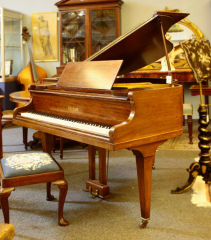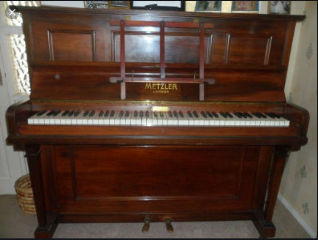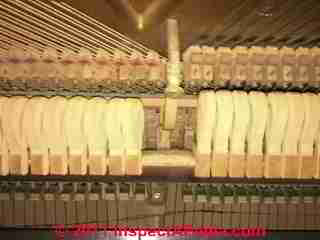 Asbestos Used in Organs, Pianos & Piano Parts
Asbestos Used in Organs, Pianos & Piano Parts
When and in what forms was asbestos used in pianos, organs, and similar instruments?
- POST a QUESTION or COMMENT about what building products and common in-building products, appliances, mechanical components were produced using asbestos materials
Asbestos found in some piano and organ components:
This article describes the common forms in which asbestos was used in pianos, player pianos, and organs. The article lists common uses of asbestos in these musical instruments and gives the brands and dates of manufacture of asbestos-containing pianos using Starr pianos as a key example.
Asbestos was used in some piano padding and may have appeared in several other forms such as fiber cement asbestos millboard in instruments built for use in humid climates.
InspectAPedia tolerates no conflicts of interest. We have no relationship with advertisers, products, or services discussed at this website.
- Daniel Friedman, Publisher/Editor/Author - See WHO ARE WE?
Asbestos Used In Pianos & Piano Parts & in Organs

Reader Question: Did the Starr Piano company use any asbestos in any part / parts in there Star Remington Model?
Reply: Here are some example photos of standard, non-asbestos piano materials found in Starr pianos as well as advice on where to look for asbestos products
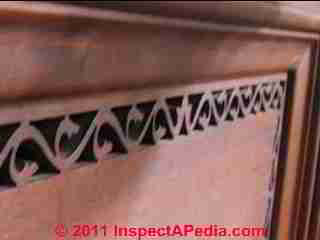 Thank you for the interesting Asbestos question about pianos. Certainly where asbestos is a general concern, an inspection onsite by an expert will provide far more assurance about asbestos risks than we can provide by web discussion.
Thank you for the interesting Asbestos question about pianos. Certainly where asbestos is a general concern, an inspection onsite by an expert will provide far more assurance about asbestos risks than we can provide by web discussion.
[Click to enlarge any image] That said:
Asbestos was used in some piano padding. I have not found a referral to asbestos specifically used within pianos themselves. However it wouldn't surprise me if pianos made for humid climates didn't use asbestos millboard for some component parts.
According to our research, The Starr Piano Company was established in Richmond, Indiana in 1872. The pianos were manufactured and distributed under the labels of Cumberland, Duchess, Gennett, Krell, Minum, Tayser, Royal, Pullman, Remington, Richmond, Coronado, Schmoller & Mueller and Starr Pianos.
Some Starr piano owners and references refer to these labels as "models" of the Star piano line.
While asbestos was widely used in many products at that time, the Cumberland photos we've seen, at least of piano exterior, use the expected wood case and hard white and black keys that may be ivory and ebony or celluloid, typically glued over wood.
Some Places to Look for Asbestos Material in a Piano

Piano key hammer felt: The white piano key hammers (photo at left of a Starr piano interior) could have been made of asbestos as that product was listed by Rosato.
Key hammer felt in most pianos is more typically organic fibers. See Rosato's reference atReferences or Citations . Note that most piano key felts are and were fabricated from wool.
Piano key hammer damper felt or cloth: the damper felt used under or behind piano keys may have contained asbestos, as cited above.
Cement asbestos millboard: Does your Starr Remington model piano include the lighted music well unique to the Starr piano line? Without having found details about the construction of the light well, I pose that a manufacturer might have used cement asbestos millboard as a light well liner for fire safety.
Dampness controls in pianos: including cement asbestos millboard components used for the construction of pianos intended to survive in damp envronments and dampness removing systems in pianos such as "Hydroceel" tubes. (Den Boer 1973 cited below).
Also see CEMENT ASBESTOS SHEET PRODUCTS
Insulation used in some pianos included vermiculite. Depending on where the vermiculite was mined it may contain asbestos. See VERMICULITE INSULATION
Light wells & light wiring: You'd want to look inside an antique piano for any questionable material such as asbestos millboard such as hidden structural components in a piano made for humid climates or around electrical components - look at the surrounding material used in the luminous music well if your Starr piano has that feature.
Because theatre wiring often used asbestos insulating jackets and because the light wiring on a piano light well might be subject to high temperature, that's another place to look.
Music racks on pianos: some piano music racks included asbestos in the 1940's, and other music racks that included lighting may include asbestos in electrical wiring insulation or heat shields. (McKenzie 1911 & Janssen 1942)
Player piano parts, incuding the piano suction turbine, discs, and other parts (Cushing 1964). Asbestos is cited as a component in the suction pump assembly of [presumably] some player piano brands and models. (Kinsler 2002)
If you have specific materials in mind from your piano then, can you send me [CONTACT] some sharp photos of the whole piano, its identifying marks/labels including inside the unit, photos of the parts in question. I can thus advise you about further sampling and testing as well as considering the question about whether or not testing is warranted.
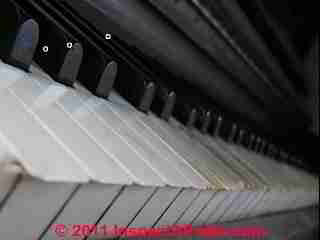 Do not disturb asbestos unnecessarily:
Do not disturb asbestos unnecessarily:
Finally, as with many asbestos-containing materials, especially non-friable materials like asbestos cement millboard, the more significant asbestos hazard would arise if you were demolishing or grinding or cutting the material. Leaving it alone or coating it in place are usually advised.
References for Star Pianos and Star Piano photos
Web search 08/13/2011, sources:
- www.waynet.org/facts/starr-piano.htm
- www.bluebookofpianos.com/agess.htm#STARR and cgi.ebay.com/Starr-Piano-Company-Rare-Vintage-Upright-Piano-1926-/270784146638? pt=Keyboards_MIDI&hash=item3f0bfe2cce - where a photo series showed only conventional piano materials at both the piano exterior and interior
- www.sellmypiano.com/uprights.aspx/509 who provided some photos of a Cumberland model Star piano from 1909-1910 vintage.
Reader Question: asbestos in 1920's Janssen Piano?
I am restoring an old Janssen piano circa 1920. I was reading your article on Asbestos in Pianos and wondering if you would please tell me if my piano may have asbestos? - Anonymous, by private email 2016/05/21
Reply:
I can't know just from your e-text. The article above lists some of the ways asbestos may have been used in pianos.
Asbestos was widely used in many brands of Pianos and may not have stopped in most countries until the late 1970's in North America or as late as the 1990's in the U.K. and some other countries.
However some piano manufacturers indicate that their pianos never contained asbestos.
If you can, send me some sharp photos of the piano and of asbestos suspect parts, I can comment further, and course know for sure you have to obtain a lab test. [Done, above].
Piano Manufacturers Who Did Not Use Asbestos
- Yamaha Pianos [citation needed]
Piano Manufacturers Known to Have Used Asbestos in Piano Parts
- Baldwin Pianos may have contained asbestos, as the Baldwin Piano factory in Cincinnati Ohio is listed among workplaces posing a hazard of jobsite asbestos exposure.
- Bentley [citation needed]
- Emmery [Uncertain, citation needed]
- Kemble [citation needed] upright pianos
Piano Manufacturers who May have Used Asbestos in Piano Parts
- [citation needed]
Piano Parts Accessories that Used or May Have Used Asbestos
- Piano Felt components such key hammers or strikers may have used asbestos (Zumbro 1932)
- Padding used in pianos: felt strips may contain asbestos
- Panels comprising pianos made to withstand damp or humid conditions were sometimes made using asbestos-cement board.
- Piano Dehumidifiers: installed in pianos located in very humid locations where humidity might damage piano components or cause mold growth, some dehumidifiers use asbestos-contaminated vermiculite.
See details at VERMICULITE HISTORY & PROPERTIES - Piano Humidifiers: Hydroceels, often manufactured using semi-solid asbestos bars; a "hydroceel" is a moisture-generating bar installed in pianos and kept damp in order to avoid piano damage should the internal relative humidity level fall too low. In short a hydroceel is a piano humidifier.
The Hydroceel is often placed just inside the piano behind a front panel and running at right angles to the piano strings. In that location the device is humidifying piano strikers as well as wood components.
Question: does our Metzler baby grand piano contain dangerous asbestos?
My sons’ piano teacher in the UK has a baby grand Metzler, it’s very old. I’m afraid it might contain asbestos but I’ve no way of finding out. Is it a reasonable worry please or is it unlikely? - Anonymous by private email 2020-01/28
Photos above and below: these are NOT the reader's Metzler baby grand but they do illustrate a Metzler baby grand piano for sale (the detailed view) or recently sold (full view of a Metzler baby grand piano) at auction by worthpoint.com/, retrieved 2020/01/28 original source https://www.worthpoint.com/worthopedia/metzler-baby-grand-piano-514505995 (piano for sale)
Reply:
I did some research looking for any documents describing the construction of Metzler pianos without useful result. Metzler, a UK firm based in London, produced a wide range of upright and baby-grand pianos between the company's founding in 1788 and (we think) the 1930s.
Metzler was also a UK music publisher for more than 100 years, between 1820 and the 1920s.
My best advice on the question of whether or not your Metzler piano contains asbestos is organized on this page., where we describe what sorts of piano parts (using asbestos cement board panels and on occasion asbestos-containing key hammers) might contain asbestos.
Unless parts on your Metzler are damaged, friable (soft crumbly), or thus shedding dust, even if asbestos was used, its' not likely that it's producing a significant level of airborne asbestos.
If it were my piano and I had your concern I'd inspect it carefully for damaged soft components and I might take a sample of any candidates, such as of one of the piano felt key hammers, to have tested by an asbestos test lab - the cost of that test is around $100. U.S. or perhaps less.
I'd like to see a photo of the piano, of its nameplate, and of its interior and key striking mechanisms.
Metzler also made upright pianos as illustrated just above, op. cit. We have no information confirming (nor denying) the use of asbestos in these pianos.
A nice nano-history of Metzler & Co. is given by Horniman Museum and Gardens who describe the company as "(active 1833 - 1931).
- The Horniman Public Museum And Public Park Trust
100 London Road
Forest Hill
London SE23 3PQ
020 8699 1872 - Website excerpt:
Metzler & Co. was a firm of London-based piano makers. The company was founded in 1788 by Valentin Metzler, and became known as Metzler & Son in 1816 when his son George Richard joined the firm. In 1833 the company name changed to Metzler & Co., presumably on Valentin's death.
The company was taken over on George Richard's death in 1867 by his son George Thomas. Metzler & Co. exhibited a piano at the Great Exhibition in 1851. The firm became a limited company in 1893, and was taken over by J. B. Cramer & Co. in 1931. - retrieved 2020/01/28 original source: Horniman, https://horniman.ac.uk/collections/browse-our-collections/authority/agent/identifier/agent-5936
Research Citations: Asbestos Use in Pianos & Piano Construction
 Shown: the McKenzie piano lamp that preferred use of asbestos for heat shielding.
Shown: the McKenzie piano lamp that preferred use of asbestos for heat shielding.
[Click to enlarge any image]
- Ahmed, A. Karim, Donald F. Macleod, and James Carmody. "Control for Asbestos." Environment: Science and Policy for Sustainable Development 14, no. 10 (1972): 16-28. cites the use of asbestos in "piano padding".
- Archer, S. R., and T. R. Blackwood. Status assessment of toxic chemicals: asbestos. Vol. 1. Environmental Protection Agency, Office of Research and Development, Industrial Environmental Research Laboratory, 1979. In this text, table 4. U.S. Asbestos Uses (3) cites asbestos papers, felts, and millboard: Piano Padding
- Brown, Frederick O. "Cushion-innersole for shoes." U.S. Patent 1,034,763, issued August 6, 1912.
Excerpt:
1 designates a relatively thick sheet of strong felt, preferably that known commercially as piano felt. Over the upper side of this felt is disposed a sheet of asbestos 2, - Camplin, Jeffery C. ASBESTOS, a "Second wind" brings contaminant back into public eye [PDF] Professional Safety 48, no. 8 (2003): 32-39.
Includes "Piano felts" among list of asbestos cloth and woven products. - retrieved 2020/01/28 original source: https://pdfs.semanticscholar.org/6040/ad3f90377173c4acb3fedd6a440edf7a83b6.pdf - Cushing, William J. "Player piano system with replay and cut-off features." U.S. Patent 3,117,481, issued January 14, 1964.
Excerpt:
It is further intended that the pouches be approximately one and one-half inches in diameter and made of imported pouch leather with an asbestos disk as 27 preferably being cemented to the center thereof. - Den Boer, J. "Device for regulating the humidity of the air in a musical instrument." U.S. Patent 3,719,033, issued March 6, 1973.
Abstract: A device for regulating the humidity of the air in a piano, comprising a container with apertures, filled with a moisture absorbing material, said material being a mixture of diatomaceous earth, asbestos powder and viscose sponge and being saturated with water by immersing the container in water, whereafter the container is mounted in the piano.
The apertures are characterized by the presence of two larger openings connected by a slot of capillary size. - Dohner, V. Alton, Robert G. Beegle, and Walter T. Miller. "Asbestos Exposure and Multiple Primary Tumors 1, 2." American Review of Respiratory Disease 112, no. 2 (1975): 181-199. cites piano padding as an abestos source;
- Goldberg, Persky, White P.C., "Baldwin Piano, Asbestos Exposure & Work History", [website], retrieved 2016/06/20, original source: http://www.gpwlaw.com/mesothelioma/mesothelioma-states/OH/cincinnati/2456/baldwin-piano/ Excerpt describing evidence of asbestos exposure:
Blueprints, diagrams, invoices from asbestos product manufacturers, revealing company memos demonstrating their knowledge of the risks, asbestos product packaging through the years, depositions from leading experts, depositions of other asbestos victims throughout Ohio and medical and scientific literature dating from the late 1800s to the current day. - Janssen, Webster E., "Illuminated music rack." U.S. Patent 2,282,135, issued May 5, 1942. Excerpt:
.
.. The glass strip rear rabbet 44 of cross wall 31. I V V The light of the bulb 39 is additionally thrown upwardly and rearwardly by abent metaljre- 42 is -shownas also resting on a the ornamental front 45 of the 'flectorj46; forming about a semi-circle around its bottom and front. r To keep the heat of the bulb 39 away from the key levers and finely finished fall board i3, the cross board 41 above the fallboard |3is shown with its top covered by an asbestos mat 48. - Janssen, Thomas B., "Musical instrument illuminating system." U.S. Patent 3,079,491, issued February 26, 1963. [This patent does NOT cite use of asbestos]
- Kinsler, Mark, "Asbestos in Player Piano Suction Turbine", [web article in PDF form] retrieved 2016/06/20, original source: http://www.mmdigest.com/Archives/Digests/200212/2002.12.01.07.html
Note: the author opines that concerns about asbestos hazards are "mostly bogus". - Mackenzie, James G. "Piano-lamp." U.S. Patent 987,004, issued March 14, 1911.
Excerpt: The body A is preferibly-lined with asbestos or equivalent material whieh being white serves as a light diffuser and also prevents excessive heating of the body - "16 CFR Chapter 11, Consumer Products Containin Asbestos, Advance Notice of Proposed Rulemaking", [PDF] U.S. Consumer Products Safety Commission, CPSC, U.S. Federal Register, Vol. 44. No 201, 17 October 1979, Proposed Rules, 60057. This document cites a long list of consumer products that contained asbestos including under the category of "Felt", Piano and organ felts.
- Zumbro, Frank R. "Method and apparatus for manufacturing carbon dioxide ice from liquid carbon dioxide." U.S. Patent 1,864,396, issued June 21, 1932.
Excerpt: "The space between the screens may be filled with a filtering material such as piano felt, asbestos or some other suitable filtering material. " [Really?] - Woodsides, Kenneth T. "A case of pulmonary asbestosis." Journal of Occupational and Environmental Medicine 9, no. 12 (1967): 627-629. cites employment in a piano factory as a source of asbestosis
...
Reader Comments, Questions & Answers About The Article Above
Below you will find questions and answers previously posted on this page at its page bottom reader comment box.
Reader Q&A - also see RECOMMENDED ARTICLES & FAQs
On 2019-10-26 - by (mod) -
Linda
Sorry I don't know offhand but we can both do some research on that. Sometimes searching them both the brand and the patents Library will give us the details on the use of asbestos in a particular piano. Of course if you have the piano you could also have a sample of the key Strikers tested
On 2019-10-25 by Linda
Just wondering if an old Mason Risch piano might contain asbestos?
On 2018-05-18 - by (mod) -
We don't know, we'll have to do some research. A photo of your Pano and any markings or labels or data tags would help.
Asbestos was widely used in many brands of Pianos and may not have stopped in most countries until the late 1970's in North America or as late as the 1990's in the U.K. and some other countries.
However some piano manufacturers indicate that their pianos never contained asbestos.
On 2018-05-17 by G. Lake
I have a Grinnell Bros. Console Piano. The Serial No. is 4-3066. The Antique Piano Shop advised the piano was built in 1947. 1. Do you know if this is correct? 2. Did this company put asbestos in their pianos?
3. If the manufacturer used asbestos and stopped the practice, please let me know the years their pianos were asbestos-free. Thank you very much!
On 2016-12-11 - by (mod) -
I don't know, Kiera.
20 y.o. felts wouldn't be asbestos but some older pianos might use asbetos millboatd or asbestos in othrr parts.
On 2016-12-10 by KIERA HUGHES
Hi
I was given a Broadwood upright steel framed Grand Piano [rosewood] manufactured approximately 1945. It was refelted around 20 years ago.The piano was apparently shipped from the UK to Australia after WW2. I was wondering if the piano is likely to contain asbestos.
Thanks so much for your help,
Kiera from Sydney.
On 2016-09-03 - by (mod) -
Ted,
The Fender Rhodes electric piano is documented in patents dating from at lest 1965 - an era when asbestos was in common use and continuing into the 1980's. I searched the patents for the word "asbestos" as often the patent disclosure would document that situation. Asbestos doen't appear in the patents - not a conclusive result but a suggestive one.
United States Patent 0 Des. 200,439 Ce Patented Feb. 23, 1965 ELECTRIC PIANO Harold B. Rhodes, 2443 Greenbriar Sh, Anaheim, Calif., assignments, of one-half to Fender- Rhodes, Inc., Fullerton, Califl, a corporation of California Filed June 18, 1964, Ser. No. 80,469
Rhodes, Harold B. "Piano action." U.S. Patent 4,338,848, issued July 13, 1982.
Also see
Barona, Maria Elisa Ayerbe. "The fender rhodes." (2014). an article about this instrument that appears in various locales including one I cite below
Excerpt:
The Fender Rhodes electric piano is one of the most important musical inventions of the twentieth century. Harold Rhodes, a musician who worked as a flying instructor stationed in Greensboro, NC during the WWII, was asked to develop a musical therapy for wounded soldiers at the hospital. Rhodes designed a small piano that could be played in bed by the recovering patients. (Adlers)
The instrument was built with parts of aluminum tubes from a dismantled B-17 bomber plane which produced a special resonance. Rhodes used these as tuning forks for a 2½ octave (29 keys) acoustic piano instrument that resembled a xylophone. When the war ended, Rhodes manufactured an amplified 38-key electric version of his original instrument called the ‘Pre-Piano,’ with pickups for every tone bar, built-in tube amplifier and speakers. This instrument was presented at the NAMM convention in 1946. (Rhodes Music Corporation)
- retrieved 2016/09/03, original source: http://www.soundgirls.org/the-fender-rhodes/
On 2016-08-31 by Ted
Have you heard of asbestos use in Fender Rhodes electric pianos or Hammond Organs?
...
Continue reading at ASBESTOS in GOOD CONDITION or select a topic from the closely-related articles below, or see the complete ARTICLE INDEX.
Or see these
Recommended Articles
- ASBESTOS IDENTIFICATION IN BUILDINGS - home
- ASBESTOS LIST of PRODUCTS - exhaustive list
Suggested citation for this web page
ASBESTOS in PIANOS at InspectApedia.com - online encyclopedia of building & environmental inspection, testing, diagnosis, repair, & problem prevention advice.
Or see this
INDEX to RELATED ARTICLES: ARTICLE INDEX to ASBESTOS HAZARDS
Or use the SEARCH BOX found below to Ask a Question or Search InspectApedia
Ask a Question or Search InspectApedia
Try the search box just below, or if you prefer, post a question or comment in the Comments box below and we will respond promptly.
Search the InspectApedia website
Note: appearance of your Comment below may be delayed: if your comment contains an image, photograph, web link, or text that looks to the software as if it might be a web link, your posting will appear after it has been approved by a moderator. Apologies for the delay.
Only one image can be added per comment but you can post as many comments, and therefore images, as you like.
You will not receive a notification when a response to your question has been posted.
Please bookmark this page to make it easy for you to check back for our response.
IF above you see "Comment Form is loading comments..." then COMMENT BOX - countable.ca / bawkbox.com IS NOT WORKING.
In any case you are welcome to send an email directly to us at InspectApedia.com at editor@inspectApedia.com
We'll reply to you directly. Please help us help you by noting, in your email, the URL of the InspectApedia page where you wanted to comment.
Citations & References
In addition to any citations in the article above, a full list is available on request.
- ASBESTOS HISTORY & PROPERTIES [Book online] D.V. Roasato, engineering consultant, Newton MA, Reinhold Publishing Co., NY, 1959, Library of Congress Catalog No. 59-12535. We are in process of re-publishing this interesting text. Excerpts & adaptations are found in InspectApedia.com articles on asbestos history, production & visual identification in and on buildings.
- "Asbestos in Plastic Compositions", A.B. Cummins, Modern Plastics [un-dated, pre 1952]
- "Asbestos in Your Home," Spokane County Air Pollution Control Authority, Spokane WA 509-477-4727 www.scapa.org provides a one-page image, a .pdf file drawing of a house warning of some possible sources of asbestos in the home. The sources are not ranked according to actual risk of releasing hazardous levels of airborne asbestos fibers and the list is useful but incomplete.
- Chrysotile [asbestos] and Its Uses, Louis Perron, Minerals and Metals Sector, Canadian Minerals Yearbook, 2002, Natural Resources Canada, web search 03/01/2011, original source: http://www.nrcan-rncan.gc.ca/mms-smm/busi-indu/cmy-amc/content/2002/20.pdf
- The US EPA provides a sample list of asbestos containing products epa.gov/earth1r6/6pd/asbestos/asbmatl.htm
- Thanks to Susan Kimball, Argus Pacific Corp., Puget Sound, WA, for pointing out that some products are permitted to contain more than 1% asbestos fibers by current standards provided that the fibers are encapsulated in an appropriate binder. Argus Pacific, in Seattle, WA 98119, 206.285.3373, is an industrial hygiene firm who also provide OSHA and DOSH regulated training in Washington State, providing classes in asbestos, lead, mold, hazardous waste, emergency response, and other occupational health, safety, and professional development topics. -- September 2008.
- " Work Practice for Window Removal and Window Putty Patching With Less Than Or Equal To 1% Asbestos Window Putty and Caulking" University of Washington, 2002 http://www.washington.edu/admin/asbestos/1putty.html
- How do I Manage Asbestos in our House or Apartment Building?, Illinois Department of Environmental Conservation, provides this article at http://www.epa.state.il.us/small-business/asbestos-in-home/
- Asbestos in buildings - employee notice, University of Washington dept. of Environmental Safety, http://www.ehs.washington.edu/ohsasbestos/index.shtm
- Window putty to be exempted from asbestos removal by State of Maine - http://list.uvm.edu/cgi-bin/wa?A2=SAFETY;wYpdKg;20010307113643-0500A
- EPA Region 6 identifies window putty as asbestos containing - http://www.epa.gov/earth1r6/6pd/asbestos/asbmatl.htm
- June 1997 - Window Putty - OSHA case cites contractor for asbestos exposure during removal of window putty http://www.osha.gov/pls/oshaweb/owadisp.show_document?p_table=NEWS_RELEASES&p_id=1091
- ASBESTOS IDENTIFICATION IN BUILDINGS How to find and recognize asbestos in buildings - visual inspection methods, list of common asbestos-containing materials
- Asbestos Identification and Testing References
- Asbestos Identification, Walter C.McCrone, McCrone Research Institute, Chicago, IL.1987 ISBN 0-904962-11-3. Dr. McCrone literally "wrote the book" on asbestos identification procedures which formed the basis for current work by asbestos identification laboratories.
- Stanton, .F., et al., National Bureau of Standards Special Publication 506: 143-151
- Pott, F., Staub-Reinhalf Luft 38, 486-490 (1978) cited by McCrone
- ASBESTOS IN YOUR HOME U.S. EPA, Exposure Evaluation Division, Office of Toxic Substances, Office of Pesticides and Toxic Substances, U.S. Environmental Protection Agency, Washington,D.C. 20460
- Asbestos products and their history and use in various building materials such as asphalt and vinyl flooring includes discussion which draws on ASBESTOS, ITS INDUSTRIAL APPLICATIONS, ROSATO 1959, D.V. Rosato, engineering consultant, Newton, MA, Reinhold Publishing, 1959 Library of Congress Catalog Card No.: 59-12535 (out of print, text and images available at InspectAPedia.com).
- EPA ASBESTOS MATERIALS BAN: CLARIFICATION 1999
- EPA Guidance for Controlling Asbestos-Containing Materials in buildings, NIAST, National Institute on Abatement Sciences & Technology, [republishing EPA public documents] 1985 ed., Exposure Evaluation Division, Office of Toxic Substances, Office of Pesticides and Toxic Substances, U.S. Environmental Protection Agency, Washington,D.C. 20460
- In addition to citations & references found in this article, see the research citations given at the end of the related articles found at our suggested
CONTINUE READING or RECOMMENDED ARTICLES.
- Carson, Dunlop & Associates Ltd., 120 Carlton Street Suite 407, Toronto ON M5A 4K2. Tel: (416) 964-9415 1-800-268-7070 Email: info@carsondunlop.com. Alan Carson is a past president of ASHI, the American Society of Home Inspectors.
Thanks to Alan Carson and Bob Dunlop, for permission for InspectAPedia to use text excerpts from The HOME REFERENCE BOOK - the Encyclopedia of Homes and to use illustrations from The ILLUSTRATED HOME .
Carson Dunlop Associates provides extensive home inspection education and report writing material. In gratitude we provide links to tsome Carson Dunlop Associates products and services.



